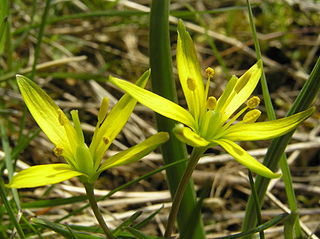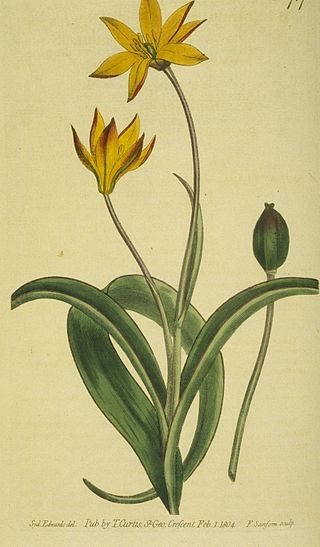
Ornithogalum is a genus of perennial plants mostly native to southern Europe and southern Africa belonging to the family Asparagaceae. Some species are native to other areas such as the Caucasus. Growing from a bulb, species have linear basal leaves and a slender stalk, up to 30 cm tall, bearing clusters of typically white star-shaped flowers, often striped with green. The common name of the genus, star-of-Bethlehem, is based on its star-shaped flowers, after the Star of Bethlehem that appears in the biblical account of the birth of Jesus. The number of species has varied considerably, depending on authority, from 50 to 300.

Gagea is a large genus of spring flowers in the lily family. It is found primarily in Eurasia with a few species extending into North Africa and one species in North America.

Gagea lutea, known as the yellow star-of-Bethlehem, is a Eurasian flowering plant species in the family Liliaceae. It is widespread in central Europe with scattered populations in Great Britain, Spain, and Norway to Siberia and Japan.

Gagea serotina, synonym Lloydia serotina, is an Arctic–alpine flowering plant of the lily family. It is widespread across the mountainous parts of western North America, from Alaska to New Mexico, and in Europe is found in the Alps and Carpathians, as well as in Great Britain. It is also native to much of Central Asia, Siberia, China, Nepal, Mongolia, Korea and Japan.
The Star of Bethlehem is a Christian tradition regarding the birth of Jesus.

Gagea minima, known as the least gagea, is a Eurasian species of plants in the lily family.

Gagea pratensis, called the yellow star-of-Bethlehem, is a European and Mediterranean plant species in the lily family. It is widespread across much of Europe as well as Turkey and Morocco. It was first described to science by Persoon in 1794.

Gagea spathacea, the Belgian gagea, is a European species of small bulbous perennial plants in the lily family. It is distinguished from other members of its genus by its large leaves and the lack of any surface ornamentation of its flower stalks and its leaves.

The TulipeaeDuby is a tribe of monocotyledon perennial, herbaceous mainly bulbous flowering plants in the Liliaceae (lily) family. As originally conceived by Duby (1828), "Tulipaceae" was a tribe within Liliaceae, consisting of the genera Tulipa, Fritillaria and Lilium.

Gagea liotardii is a Eurasian and North African species of plants in the lily family. It is a bulb-forming perennial up to 15 cm tall. Flowers are generally bright yellow to yellow-green. Its native range stretches from Spain and Morocco to Mongolia.

Gagea bulbifera is a Eurasian species of plants in the lily family, widespread from Romania to Xinjiang. It is native to Romania, Russia, South Caucasus, Kazakhstan, Kyrgyzstan, Iran, Turkey, Xinjiang, Western Himalayas.
Gagea olgae is an Asian species of plants in the lily family. It is native to Iran, Pakistan, Afghanistan, Kyrgyzstan, Tajikistan, Uzbekistan, Kazakhstan, and Xinjiang.
Gagea kunawurensis is an Asian species of plants in the lily family. It is native to Central Asia, Xinjiang, Afghanistan, Iran, Pakistan, Western Himalayas, and South Caucasus.
Gagea tenera is an Asian species of flowering plants in the lily family. It is native to Xinjiang, Central Asia, the Western Himalayas, Iran, Turkey, and South Caucasus.

Gagea chrysantha is a European species of plants in the lily family, found only in Sicily, Italy. Similar populations from the eastern Mediterranean have long been referred to G. chrysantha but recent evidence suggests that this group is actually a complex of several species rather than a single species.
Gagea dubia is a Mediterranean species of plants in the lily family. It is native to Morocco, Spain, France, Sardinia, Sicily, Greece including Crete, Turkey, Syria, Lebanon, and Iran.

Gagea lacaitae is a Mediterranean and Black Sea species of plants in the lily family. It is native to Spain incl. Balearic Islands, France incl. Corsica, Italy, Morocco, and Algeria.

Gagea peduncularis is a Mediterranean plant species in the lily family. It is native to Italy (Apulia), Greece, the Balkans, Turkey, Cyprus, and Libya.
Gagea ramulosa is a Eurasian and North African plant species in the lily family. It is native to France, Sardinia, Sicily, Greece, Turkey, Libya, Ukraine, European Russia, Caucasus, Syria, Lebanon, Iraq, Iran, and Afghanistan. Some authors consider this to be the same species as G. dubia, but the World Checklist does have it listed as a distinct species.
Gagea soleirolii is a European flowering plant of the lily family. It is native to Spain, France, Portugal and Sardinia.













